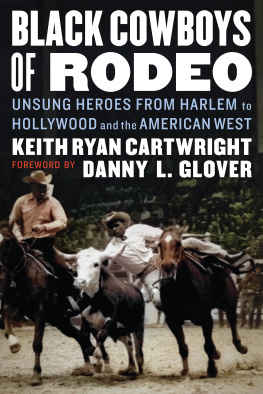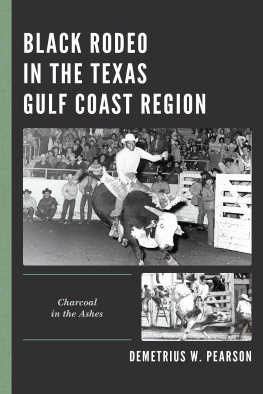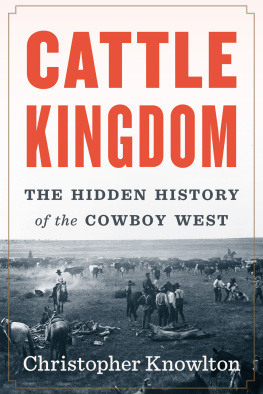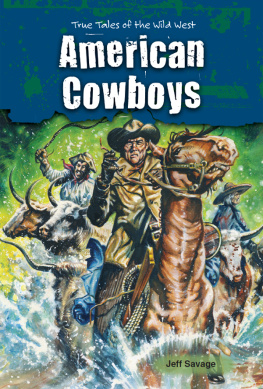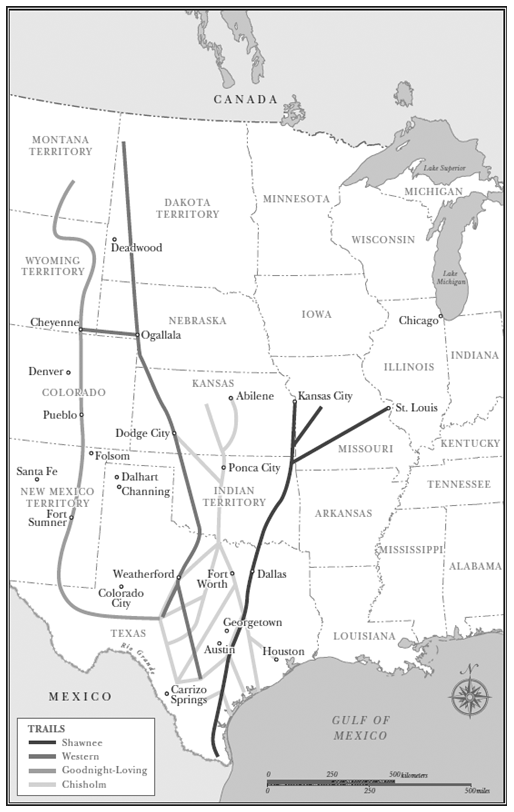BLACK
COWBOYS
OF THE
OLD WEST
Copyright 2011 by Tricia Martineau Wagner
ALL RIGHTS RESERVED. No part of this book may be reproduced or transmitted in any form by any means, electronic or mechanical, including photocopying and recording, or by any information storage and retrieval system, except as may be expressly permitted in writing from the publisher. Requests for permission should be addressed to Globe Pequot Press, Attn: Rights and Permissions Department, P.O. Box 480, Guilford, CT 06437.
TwoDot is a registered trademark of Morris Book Publishing, LLC.
Project editor: David Legere
Text design: Sheryl P. Kober
Layout: Melissa Evarts
Map: Melissa Baker Morris Book Publishing, LLC
Library of Congress Cataloging-in-Publication Data
Wagner, Tricia Martineau.
Black cowboys of the Old West : true, sensational, and little-known stories from history / Tricia Martineau Wagner.
p. cm.
Includes bibliographical references and index.
ISBN 978-0-7627-6071-8
1. African American cowboysWest (U.S.)History19th century. 2. African American cowboysWest (U.S.)Biography. 3. African AmericansWest (U.S.)History19th century. 4. Ranch lifeWest (U.S.)History19th century. 5. RodeosWest (U.S.)History19th century. 6. Wild west showsHistory19th century. I. Title.
F596.W25 2011
978'.02dc22
2010039725
Printed in the United States of America
10 9 8 7 6 5 4 3 2 1
For my family, Mark, Kelsey, and Mitch ~ I am blessed.
The life was hard and in some ways exacting, yet it was free and wild and contained the element of danger which my nature craved.
NAT LOVE, 18541921
ACKNOWLEDGMENTS
- Erin H. Turner, my editor at Globe Pequot Press, for her expertise and professionalism in preparing this book for publication.
- David Legere and Ellen Urban, editors at Globe Pequot Press, who made the editing process simply enjoyable.
- Dr. Richard W. Slatta, professor of history at North Carolina State University, for his valuable critique and insight on revisions.
- Angie Wiggs High, for her timely research assistance that was greatly appreciated.
- Mary Kemp and Leon Tanner, Parker county historians, Nebo Valley Press, Weatherford, Texas, for sharing their wealth of research information, their book about Bose Ikard, and his photograph.
- Angeline Beljour, senior reference librarian at the Schomburg center for Research in Black culture, for her comprehensive list of research materials, which proved to be invaluable.
- George Miles, at the Yale collection of Western Americana at the Beinecke Rare Book & Manuscript Library, for investigating research institutions and for locating rare articles.
- Chuck Rand, director at the Dickinson Research Center at the National Cowboy & Western Heritage Museum, for identifying research materials.
- The staff at the Carmel Branch of the Public Library of charlotte & Mecklenburg county, for their assistance in processing an endless list of interlibrary loan books.
- Jean Bennett, at the Weatherford Public Library in Weatherford, Texas, for locating pertinent newspaper articles.
- Mark Sanders, at the Joyner Library in Greenville, North Carolina, for scanning and sending articles that I was in immediate need of.
- My extended family and friendsyou know who you arefor your continued interest in my work, especially Walt Martineau and Lois Holmes, and Kate Brophy, Tania DeYoung, Lorie Helms, Melissa Johnson, Terry Pearlman, Joan Rush, Sharon Sacksteder, Anita Sanchez, and Beth Wilson. Thank you.
- My husband, Mark, and our children, Kelsey and Mitch, for their support and encouragement in the writing of this book. Love you.
INTRODUCTION
The cowboythe symbol of the American Westbecame the personification of courage, skill, and rugged individualism to onlookers. People view the gun-toting, tough-minded, levelheaded cowboy as the embodiment of raw masculinity, a master horseman and an expert shot. In reality most cowboys were poor shots and were disallowed from carrying weapons on ranches. The highly regarded broncobusters were master horsemen, but they were the exception rather than the rule. Nonetheless, the cowboy remains bigger than life. The quintessential cowboy is a composite figure; no one person characterizes the man. Yet he represents an exceptional breed of men uniquely loyal in purpose and seemingly unencumbered by responsibility other than to himself. Twenty-first-century Americans continue to live vicariously through the cowboy; secretly, nobody wants to be hemmed in.
As the American cowboy rode the range, he became a national folk heroa cultural icon so romanticized that he morphed into a mythological figure of epic proportions. With the passage of time, the lover of history, fiction, music, and art, while seeking to know the cowboy, inadvertently contributed to deifying him.
However, the image of the American cowboy has been packaged and marketed as a white entity. American Western literature produced a plethora of pulp fiction that popularized the cowboy myth and immortalized him in the American psyche. Owen Wisters 1902 book, The Virginian, was widely recognized as the first cowboy novel, but it did not contain one black cowboy, nor did Andy Adamss 1903 well-read book, The Log of a Cowboy. The stories of white cowboys were written by white authors for a white audience.
The film industry also did its fair share to create such imagery: American cowboys became legendary heroes fabulously glamorized by the Hollywood Western picture show. Even the actor portraying Jim Beckwourth, the famous black frontiersman and trailblazer of the 1800s, was played by a white man in a 1950 film. In reality, the cowboys of the American West were also of Hispanic, African-American, and Native American descent. Until recently their stories have been largely untold. AS one descendant of a black cowboy explained, We didnt write the books. We didnt produce the movies. So we were politely deleted. There is a conspicuous absence of the black cowboy recorded in the history of the American cattle-ranching industry. The role these men played in the settling of the Old West deserves scholarly attention.
As a youngster, Paul Stewart never read about black cowboys in Western fiction. He erroneously concluded there was no such thing until the day he saw a black cowboy in Denver, Colorado, in the 1930s. Forty years later, Stewart opened the Black American West Museum and Heritage Center in Denver to fill a void in history. In 1991 cowboy Cleo Hearn established the Cowboys of Color Rodeo Tour, a multicultural rodeo open to African-American, Hispanic, and Native American cowboys and cowgirls. Hearn was five years old when he saw his first black cowboy in 1944, and it left an indelible impression.
The ten remarkable men in Black Cowboys of the Old West


